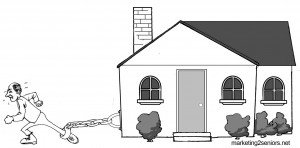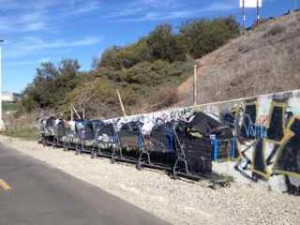
by Diane Masson | Apr 6, 2014
 There was an overwhelming response of ideas and tactics through Linked In of “How To Move Someone Saying, “No!” (Part 1).
There was an overwhelming response of ideas and tactics through Linked In of “How To Move Someone Saying, “No!” (Part 1).
Many people felt that you should never force a senior parent to move. Once the conversation specified parents with dementia, then everyone was onboard with possible solutions. Let me sum up the best strategies and “schemes” on how to move someone who is at risk and seems chained to their current home.
- Move your parent directly from a hospital crisis to a senior living community.
- Be ready to transition your parent to an assisted living community when the rehabilitation is over.
- Say, “As soon as you are better, I will move you back to your home.”
- The primary care physician can convince mom or dad that it is time to move and list the reasons why. (This generation is programed to abide by the doctor’s recommendations.)
- Bring a contractor by your parent’s home and say, “We need to work on the house and the plumbing will be shut down for two weeks. You are only going to move temporarily while the house gets worked on…”
- Sample stays of two to seven nights – to test-drive a retirement community.
- Show them where you want them to move and compare with an awful place they dislike.
- Send them to an adult day program for several weeks before moving them in full time.
- Sometimes you just need to push them to the next step when your parent’s health dictates it.
- The safety of your parent means switching the child/parent roles. You the Boomer child becomes the parent and makes the decision.
- Cajoling: Asking for the GIFT of peace-of-mind from worrying about them.
- Cultivating a move can take months. Include as many lunches and residents activities as possible at a prospective senior living community.
FYI – If a retirement community knows that you are struggling they will triple their efforts to help you and support your parent(s) integration into their community.
Remember that 95% of cognitive seniors who move all say, “I wish that I had moved sooner.” Once they start thriving they won’t want to move back to their isolated home. Patience and empathy are two necessary ingredients that must be present for your parent’s transition.
Any more ideas?
Please share your successes, failures or comment below to join the conversation and interact with other senior living professionals on what is currently being effective to increase occupancy on a nationwide basis.
Diane Twohy Masson is the author of “Senior Housing Marketing – How to Increase Your Occupancy and Stay Full,” available at Amazon.com with a 5-star rating. The book is required reading at George Mason University as a part of its marketing curriculum. Within this book, the author developed a sales & marketing method with 12 keys to help senior living providers increase their occupancy. Masson developed this expertise as a marketing consultant, sought-after blogger for senior housing and a regional marketing director of continuing care retirement communities in several markets. She has also been a corporate director of sales and a mystery shopper for independent living, assisted living, memory care and skilled care nursing communities in multiple states. Currently, Masson is setting move-in records as the regional marketing director of two debt-free Continuing Care Retirement Communities in Southern California – Freedom Village in Lake Forest and The Village in Hemet, California. Interestingly, this career started when she was looking for a place for her own mom and helped her loved one transition through three levels of care.
© Marketing 2 Seniors| Diane Twohy Masson 2013 All Rights Reserved. No part of this blog post may be reproduced, copied, modified or adapted, without the prior written consent of the author, unless otherwise indicated for stand-alone materials. You may share this website and or it’s content by any of the following means: 1. Using any of the share icons at the bottom of each page. 2. Providing a back-link or the URL of the content you wish to disseminate. 3. You may quote extracts from the website with attribution to Diane Masson CASP and link https://www.marketing2seniors.net For any other mode of sharing, please contact the author Diane Masson.

by Diane Masson | Mar 30, 2014
 It would be very interesting for independent, assisted living and group homes to share examples of people who moved into your senior living community who initially said, “No, I don’t want to leave my home!” How many senior living residents have you experienced in this situation?
It would be very interesting for independent, assisted living and group homes to share examples of people who moved into your senior living community who initially said, “No, I don’t want to leave my home!” How many senior living residents have you experienced in this situation?
Two weeks ago, I heard the story of an independent couple whose Boomer children moved them one hour closer to them. The dad said that he had left heel marks all the way up the freeway, because he didn’t want to move. Now, both he and his wife love living at their new Continuing Care Retirement Community that is located by their children and grandchildren.
Tonight, I heard about Jim and Joan’s dad. He was clinically depressed and stayed in his pajamas all day. He only put on clothes when Jim picked him up (drove him one block) to spend time with his wife and grandchildren. Once his dad, Dwayne, got to their house and had dinner, he didn’t want to leave, even at 11:00 PM. Jim and his wife Carol both had to be at work at 7:00 AM. They literally had to take a resistant Dwayne back to his home each evening. This went on every night for one year. Jim finally reached the breaking point.
Jim and his sister Joan went to find a retirement community for their dad. They had it all set up and then drove their dad to his new home. The entire way there, Dwayne kept saying, “No, no, no!” They said, “Dad, you will love it, give it a chance.” They showed him his new home and he was still resistant. Jim kept saying, “Dad, give it a chance,” and left. Two weeks later the dad was happier than he had been in his own isolated home. Dwayne spent five of the happiest years of his life there. Medication management and socialization had improved the quality of his life.
Nine years ago, my own mom was struggling (for over a year) in the independent living area of a Continuing Care Retirement Community. My sister, husband and I moved all my mom’s stuff to assisted living while her granddaughter took her to lunch. My daughter drove my mom back to her new home in assisted living. We were all there to greet them. My mom was shocked, but what could she do? We had moved her. It was done. The staff was all on board and had acclimated her before we left. Oh, the guilt I felt, but knew it was the right thing for her. We got a call in the night, because my mom had peed in a garbage can. Was it defiance or dementia? We will never know, but two weeks later she was happy and content. She steadily improved with three nutritious meals a day and medication management. My mom enjoyed seven years in that supportive environment.
Is it mean to move someone saying no? Or is it the best thing in the world?
Please share your successes, failures or comment below to join the conversation and interact with other senior living professionals on what is currently being effective to increase occupancy on a nationwide basis.
Diane Twohy Masson is the author of “Senior Housing Marketing – How to Increase Your Occupancy and Stay Full,” available at Amazon.com with a 5-star rating. The book is required reading at George Mason University as a part of its marketing curriculum. Within this book, the author developed a sales & marketing method with 12 keys to help senior living providers increase their occupancy. Masson developed this expertise as a marketing consultant, sought-after blogger for senior housing and a regional marketing director of continuing care retirement communities in several markets. She has also been a corporate director of sales and a mystery shopper for independent living, assisted living, memory care and skilled care nursing communities in multiple states. Currently, Masson is setting move-in records as the regional marketing director of two debt-free Continuing Care Retirement Communities in Southern California – Freedom Village in Lake Forest and The Village in Hemet, California. Interestingly, this career started when she was looking for a place for her own mom and helped her loved one transition through three levels of care.
© Marketing 2 Seniors| Diane Twohy Masson 2013 All Rights Reserved. No part of this blog post may be reproduced, copied, modified or adapted, without the prior written consent of the author, unless otherwise indicated for stand-alone materials. You may share this website and or it’s content by any of the following means: 1. Using any of the share icons at the bottom of each page. 2. Providing a back-link or the URL of the content you wish to disseminate. 3. You may quote extracts from the website with attribution to Diane Masson CASP and link https://www.marketing2seniors.net For any other mode of sharing, please contact the author Diane Masson.

by Diane Masson | Feb 16, 2014

This is the arrangement the next day…
My sweetie didn’t intend to send me dead flowers for Valentine’s Day. He saw a beautiful arrangement online and had it delivered to my office as a special surprise. When I opened the box the flowers were closed, dried out, brown on the petal edges and shockingly in no water. What??!!? I pulled them out, read the lovely note from husband and put them in water to save them or bring them back to life. My husband was upset when he saw them and said he never would have ordered them if he had known they would arrive in this condition. He thought he had ordered flowers from a florist and they would arrive like the picture shown.
This Valentine snafu reminds me of how adult Boomer children select a retirement, assisted living, memory care or skilled nursing community based on the size of the apartment and what the lobby looks like versus the quality of care. Almost every Boomer child wants the best for his or her parent, but some judge senior living community solely on external appearances.
In multiple states, I have encountered loving caring staff at senior living communities that have not been recently remodeled, with small apartments or don’t have enormous acreage. It is very challenging to market these properties, but I have witnessed some amazing sales people overcome this dilemma.
They say the best defense is a strong offense.
Here is what one marketer said in Washington state about tired furniture in the lobby: “We don’t have a big brand new building with a lavish lobby entrance but what we do have is a very comfortable loving family atmosphere where our residents are the focus of our care and attention.”
In Utah, a retirement counselor working at an independent retirement community that needed remodeling would say: “We don’t have all the bells and whistles of the community down the street, but we are home to 120 residents and you won’t find friendlier staff or residents any where else. I encourage you to meet some of the residents of both communities and judge for yourself who is happier. Then decide where you want your mom to live.”
An assisted living community in California with less community spaces says: “Initially our community seems small but it is so much easier for our senior residents to live here on a day-to-day basis. It gives the residents a sense of security to know they can navigate the community without getting lost.”
Does your senior living community live up the pictures in your brochure and what the sales people promise? It’s never good to show a wonderful picture and deliver poor quality, like when I received the dead flowers. If you don’t have the ideal gorgeous community, you can still be proud of providing the best care and services to your residents.
Please share your successes, failures or comment below to join the conversation and interact with other senior living professionals on what is currently being effective to increase occupancy on a nationwide basis.
Diane Twohy Masson is the author of “Senior Housing Marketing – How to Increase Your Occupancy and Stay Full,” available at Amazon.com with a 5-star rating. The book is required reading at George Mason University as a part of its marketing curriculum. Within this book, the author developed a sales & marketing method with 12 keys to help senior living providers increase their occupancy. Masson developed this expertise as a marketing consultant, sought-after blogger for senior housing and a regional marketing director of continuing care retirement communities in several markets. She has also been a corporate director of sales and a mystery shopper for independent living, assisted living, memory care and skilled care nursing communities in multiple states. Currently, Masson is setting move-in records as the regional marketing director of two debt-free Continuing Care Retirement Communities in Southern California – Freedom Village in Lake Forest and The Village in Hemet, California. Interestingly, this career started when she was looking for a place for her own mom and helped her loved one transition through three levels of care.
© Marketing 2 Seniors| Diane Twohy Masson 2013 All Rights Reserved. No part of this blog post may be reproduced, copied, modified or adapted, without the prior written consent of the author, unless otherwise indicated for stand-alone materials. You may share this website and or it’s content by any of the following means: 1. Using any of the share icons at the bottom of each page. 2. Providing a back-link or the URL of the content you wish to disseminate. 3. You may quote extracts from the website with attribution to Diane Masson CASP and link https://www.marketing2seniors.net For any other mode of sharing, please contact the author Diane Masson.

by Diane Masson | Feb 9, 2014

Over Sharing?
Believe it or not, I heard a senior living sales person say, “My cat has diarrhea,” to a hot prospect.” They blew the sale, because the senior was so worried about the sick cat. Really?!!?
Do you accentuate the positive and eliminate the negative at your senior living community? Maybe you better check. It’s easy for senior living marketing people to over compensate and share what you do you do not offer. They are just trying to be helpful to the customer. They are not trying to sabotage sales and send seniors to the competitor.
Every retirement community has its strong points and weak points. It does not matter if you are brand new or 25 years old. Always showcase your strengths. Is this something that you teach your senior living advisors? How do they learn it? Don’t make an assumption that they will learn it by osmosis.
Here is an expert from a chapter in my book called, “ Never Say to the Customer.”
There is such a thing as being too honest with the customer with statements such as:
- “You were on my list to call today.”
- “You were on my schedule to be followed up with today.”
- Telling the customer we will retain 10%. Instead saying, “The entrance fee is 90% refundable to your estate.”
- NEVER EVER refer to people as “a sale!”
- Please don’t call them a “prospect” in their presence or to their face. They are all your “guests,” in this book; I have referred to them as “prospective guests.” Please note: The term “prospect” or “prospective guests” is meant for marketing and is only to be used in-house. In the prospect’s presence the term to use is “guest.” I might say, “Mrs. Jones, I have an appointment later with another “guest” who is interested in this two-bedroom apartment home with the view of the park.”
I have literarily had three different types of sales people in the last week say, “I am following up with you.” It makes me cringe. How about you?
Please share your successes, failures or comment below to join the conversation and interact with other senior living professionals on what is currently being effective to increase occupancy on a nationwide basis.
Diane Twohy Masson is the author of “Senior Housing Marketing – How to Increase Your Occupancy and Stay Full,” available at Amazon.com with a 5-star rating. The book is required reading at George Mason University as a part of its marketing curriculum. Within this book, the author developed a sales & marketing method with 12 keys to help senior living providers increase their occupancy. Masson developed this expertise as a marketing consultant, sought-after blogger for senior housing and a regional marketing director of continuing care retirement communities in several markets. She has also been a corporate director of sales and a mystery shopper for independent living, assisted living, memory care and skilled care nursing communities in multiple states. Currently, Masson is setting move-in records as the regional marketing director of two debt-free Continuing Care Retirement Communities in Southern California – Freedom Village in Lake Forest and The Village in Hemet, California. Interestingly, this career started when she was looking for a place for her own mom and helped her loved one transition through three levels of care.
© Marketing 2 Seniors| Diane Twohy Masson 2013 All Rights Reserved. No part of this blog post may be reproduced, copied, modified or adapted, without the prior written consent of the author, unless otherwise indicated for stand-alone materials. You may share this website and or it’s content by any of the following means: 1. Using any of the share icons at the bottom of each page. 2. Providing a back-link or the URL of the content you wish to disseminate. 3. You may quote extracts from the website with attribution to Diane Masson CASP and link https://www.marketing2seniors.net For any other mode of sharing, please contact the author Diane Masson.

by Diane Masson | Jan 26, 2014

Wouldn’t life be simpler with less stuff?
This thought stuck me today, when I saw a homeless man with nine carts of stuff. I had to take a picture of it. How could he ever move to a new location? It would be no easy feat to roll nine carts of stuff along.
Prospective senior residents considering a retirement community or assisted living have to feel the same way. It is so overwhelming to think about moving years of memories and stuff. A frail senior may feel it is easier to just struggle in his or her home with navigating stairs, managing a walker, asking neighbors to transport them to medical appointments and eating TV dinners.
The quality of a senior’s life in this frail condition is not good. But the flip side is they get to live amongst all their stuff.
It is interesting to watch the adult Boomer children get into the mix. Some want mom or dad to continue in the family home and either can’t see or ignore the reality of the parent struggling to just eat, bathe and take medications. Other children see the danger and can’t sleep worrying for their parent’s safety and health condition.
This is our reality as senior living professionals. We must never forget how hard it is to move and what a chore it is to downsize our stuff. Our compassion is what compels many seniors to move into one of our communities. Thank you for each senior that you personally helped facilitate move into a retirement or assisted living community. I believe they have a better quality of life with more nutritious food, a greater feeling of independence if they no longer drive and a support system for medical emergencies. How do you feel?
Please share your successes, failures or comment below to join the conversation and interact with other senior living professionals on what is currently being effective to increase occupancy on a nationwide basis.
Diane Twohy Masson is the author of “Senior Housing Marketing – How to Increase Your Occupancy and Stay Full,” available at Amazon.com with a 5-star rating. The book is required reading at George Mason University as a part of its marketing curriculum. Within this book, the author developed a sales & marketing method with 12 keys to help senior living providers increase their occupancy. Masson developed this expertise as a marketing consultant, sought-after blogger for senior housing and a regional marketing director of continuing care retirement communities in several markets. She has also been a corporate director of sales and a mystery shopper for independent living, assisted living, memory care and skilled care nursing communities in multiple states. Currently, Masson is setting move-in records as the regional marketing director of two debt-free Continuing Care Retirement Communities in Southern California – Freedom Village in Lake Forest and The Village in Hemet, California. Interestingly, this career started when she was looking for a place for her own mom and helped her loved one transition through three levels of care.
© Marketing 2 Seniors| Diane Twohy Masson 2013 All Rights Reserved. No part of this blog post may be reproduced, copied, modified or adapted, without the prior written consent of the author, unless otherwise indicated for stand-alone materials. You may share this website and or it’s content by any of the following means: 1. Using any of the share icons at the bottom of each page. 2. Providing a back-link or the URL of the content you wish to disseminate. 3. You may quote extracts from the website with attribution to Diane Masson CASP and link https://www.marketing2seniors.net For any other mode of sharing, please contact the author Diane Masson.

by Diane Masson | Jan 19, 2014
 This picture is worth a thousand words. What is the state of your available apartments? On a recent trip to Oregon, the best place in town had this in the tub. I wanted to throw up. Really? Yet, I have seen this and worse when mystery shopping senior living communities.
This picture is worth a thousand words. What is the state of your available apartments? On a recent trip to Oregon, the best place in town had this in the tub. I wanted to throw up. Really? Yet, I have seen this and worse when mystery shopping senior living communities.
Your maintenance team is overworked and they don’t have time to do apartment renovations. So many senior residents are moving out…maintenance can’t keep up. So senior living sales people have to show apartments that are not clean or renovated. Is this fine at your retirement community? Non-renovated apartments have sold that way before, right?
Wrong?!!! This is a poor long-term strategy and bad first impression to fill the building and increase occupancy. Don’t listen to the maintenance team blues! Here are four quick solutions if your retirement community is in this boat…
- Only show model apartments period. Never ever show a disgusting apartment that someone just moved out of. It is not available to show ever!!!!
- If you don’t have model apartments, make arrangements with a few residents to show their apartments. It’s always nice to have one or two residents who say you may show their apartment anytime.
- Have housekeeping clean up the disgusting apartment now, before it is shown to single a person. (I know this is double work for housekeeping, cleaning it before and after renovation. The extra clean does help sell apartments and improves first impressions.)
- The fourth choice is to pay an outside company to renovate apartments at your senior living community. I know it costs more money than doing it in-house. Please look at it in a new way…every month that an apartment remains empty, the senior living organization loses $2,000 to $6,000 in a monthly fee.
Please give sales and marketing the tools they need to create great first impressions and sell it now. Showing models works great for a senior just looking or thinking two or three months out. If you want those 48-hour move-ins or two-week move-ins, then clean up the apartments that need to be sold now.
Please share your successes, failures or comment below to join the conversation and interact with other senior living professionals on what is currently being effective to increase occupancy on a nationwide basis.
Diane Twohy Masson is the author of “Senior Housing Marketing – How to Increase Your Occupancy and Stay Full,” available at Amazon.com with a 5-star rating. The book is required reading at George Mason University as a part of its marketing curriculum. Within this book, the author developed a sales & marketing method with 12 keys to help senior living providers increase their occupancy. Masson developed this expertise as a marketing consultant, sought-after blogger for senior housing and a regional marketing director of continuing care retirement communities in several markets. She has also been a corporate director of sales and a mystery shopper for independent living, assisted living, memory care and skilled care nursing communities in multiple states. Currently, Masson is setting move-in records as the regional marketing director of two debt-free Continuing Care Retirement Communities in Southern California – Freedom Village in Lake Forest and The Village in Hemet, California. Interestingly, this career started when she was looking for a place for her own mom and helped her loved one transition through three levels of care.
© Marketing 2 Seniors| Diane Twohy Masson 2013 All Rights Reserved. No part of this blog post may be reproduced, copied, modified or adapted, without the prior written consent of the author, unless otherwise indicated for stand-alone materials. You may share this website and or it’s content by any of the following means: 1. Using any of the share icons at the bottom of each page. 2. Providing a back-link or the URL of the content you wish to disseminate. 3. You may quote extracts from the website with attribution to Diane Masson CASP and link https://www.marketing2seniors.net For any other mode of sharing, please contact the author Diane Masson.

 There was an overwhelming response of ideas and tactics through Linked In of “How To Move Someone Saying, “No!” (Part 1).
There was an overwhelming response of ideas and tactics through Linked In of “How To Move Someone Saying, “No!” (Part 1).




